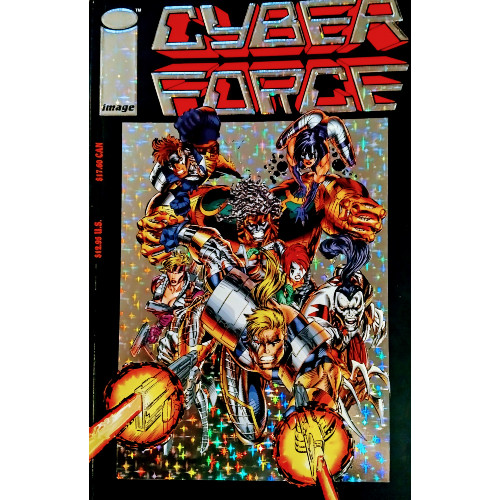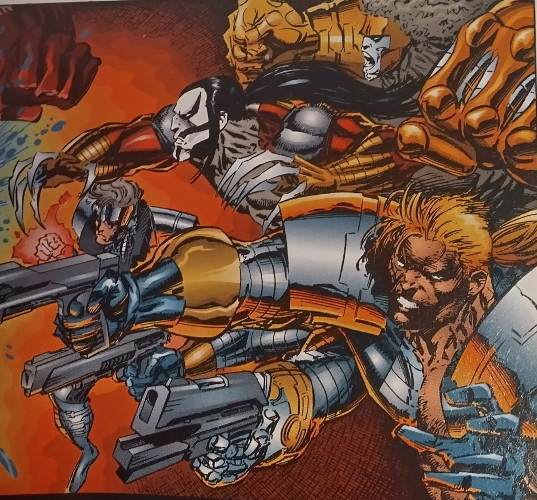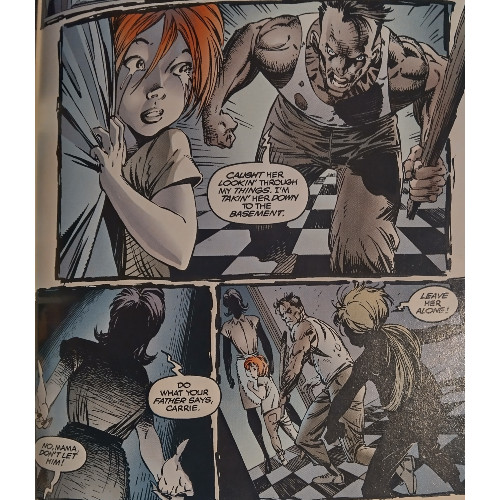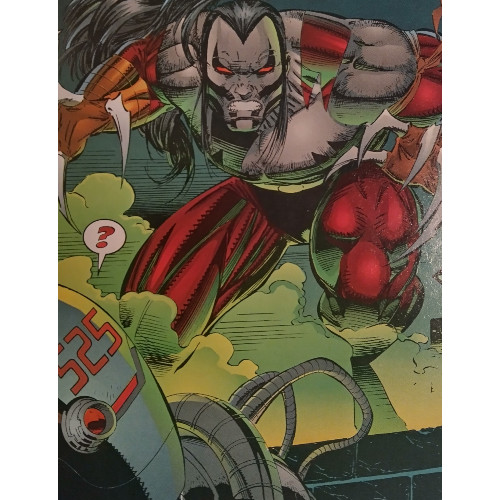Random Reviews: Cyberforce: The Tin Men of War (The Image Review-lution, Part 6)
Violence and assorted characters diminish an intriguing central protagonist whose development is hastened by disappointing twists
—by Nathan on January 8, 2024—

As I continue my way through Image Comics' earliest series, I find each volume a little more difficult to discuss than the last, with the exception of Erik Larsen's Savage Dragon. As I've discussed in other reviews, these are, generally, not great stories. They're certainly founded on interesting ideas–a resurrected assassin seeking justice, a vigilante whose identity we do not know, a team of mercenaries battling mystical threats–but the writing and art often scrape along one another as visual storytellers try their hand at dialogue and exposition. Think of metal against metal, the grinding of your car as you misjudge the distance between you and the vehicle in front of you as you turn into an empty parking space.
Not that I'm speaking from experience.
I say this because, admittedly, I've been putting off the next installment of "The Image Review-lution." When I initiated this a few months back, I was largely excited. I imagined the process of reading and writing and editing and grew engaged by what I pictured producing…
…and then I got into the reading and writing and editing, and the experience became much duller than anticipated.
It's with that mindset I entered this second-to-last early Image series, Marc Silvestri's Cyberforce. A little beaten down by the concern of reading yet another mediocre mass of messy melodrama. I even gave myself a little break, interrupting my string of Image reviews to discuss a Christmas caper published by Boom! Studios.
But I'm back. And I read this volume. And I'm here on the other side. And I'm ready to tell you all about it.
Cyberforce: The Tin Men of War
Writer: Eric Silvestri
Penciler: Marc Silvestri
Inkers: Marc Silvestri, Scott Williams, John Tighe, Dan Panosian, Trevor Scott, John Dickenson
Colorists: Joe Chiodo, Olyoptics, Wendy Broome, Ben Fernandez, Paige Apfellbaum
Letterers: Mike Heisler, Kevin Cunningham
Issues Collected: Cyberforce (vol. 1) #1-4
Volume Publication Date: December 1993
Issue Publication Dates: October 1992, March 1993, May 1993, July 1993
Publisher: Image Comics

I should first note that, even though Marc Silvestri is responsible for creating the team and providing the pencils and inks for this four-issue series, he does not write it, as you can see in the credits. His brother, Eric Silvestri, wrote these issues, and if the Image Comics database is anything to go by, they marked his first foray into comic book writing. He went on, it appears, to write other Cyberforce issues. I say all this to indicate that I am happy to give him the benefit of the doubt, that the jumbled story we find here is the result of someone not accustomed to working in this particular field.
Because this first Cyberforce series is a mess.
Like with other Image Comics narratives I've perused, there's a decent underlying concept beneath the muck and morass: a young woman, on the run from bounty hunters, is rescued by Cyberforce and allowed onto their team. There are shades here of a lost soul seeking family, belonging, shelter, and safety. The first issue's opening sequence juxtaposes her terror against the bravado of a group of superhumans brave enough to pluck her from the hands of her pursuers. And in the background, sinister forces coalesce as a political leader schemes.

And I do mean "forces." And not just "Cyberforces."
This series, like its brethren, suffers from wanting to get too much accomplished in the limited space it's allowed. Much of the mess comes from the sheer amount of characters which descend upon the pages. If you're already overwhelmed by the introduction of this young woman, the Cyberforce heroes who rescue her, and the bounty hunters who pursue her (who pop back up as recurring foes), you'll also need to contend with the series' primarily villain, supporting cast members, a second group of bounty hunters, and a cameo from Dale Keown's Pitt. It's…just a lot. It'd even be a lot to absorb across a longer series if the Silvestri brothers believed all these introductions were necessary right from the beginning. But this is just four issues. I don't know how much of the story or how many of the characters spilled into the ongoing Cyberforce series, but as it's presented here, I feel I can hardly catch my breath.

It's an appropriate sentiment, given the main protagonist is named Velocity and spends a good chunk of time running. She's the character the Silvestris want the audience to latch onto and connect with. Her plight is established from the opening page. We're supposed to feel connected to her struggles and her fear, her need to act and stand up for a friend in danger in response to being taken in by Cyberforce. We're supposed to pick up hints from her backstory and resonate with the tragedy in her life. But overwhelmed with all the other characters thrown at us, I failed to connect with Velocity. I empathized, certainly. I never wanted to see her hurt. But I didn't feel any great emotion towards who she was as a character or cared much to see her develop.
Velocity's story is paired with back-to-back plot twists which are, in my estimation, wholly undeserved. They're connected to that backstory I referenced earlier, and though I had the foresight to at least assume Velocity's tragic childhood would somehow shape her in the present, I couldn't in a million years predict how the Silvestris would do it. The twists blindside you. There's no build-up. The single clue you have is a character's yellow hair color, associating them with a younger version of themself, and I wouldn't be surprised if the Silvestris saw two blond characters and decided they were one and the same person. It's the goofiest twist since John Byrne decided Norman Osborn and the Sandman were cousins because they both have cornrows.

The twist should be surprising, it should offer a connection between characters, it should allow Velocity's tragedy to make sense and answer previously unanswered questions. I will concede it does the latter, but the problem is I didn't know those were questions I needed to ask before the Silvestris gave me the answer. Imagine you wrote a story about a character whose brother died years before and then revealed their cousin at the big family reunion was their brother the whole time without ever seeding in you'd be making such a revelation. Maybe the reader thought the story would be about your character dealing with their grief and the reunion would somehow catalyze that healing. Instead, you skip through the interesting wrestling match between a character and their trauma and offer a straightfoward solution that heals without the developmental conflict. That's what Velocity's story feels like.
Blended in with Velocity are the other characters, all of whom fill that "cool" factor without feeling overly significant to the plot. You've got a big dude named Impact, a Wolverine knockoff named Ripclaw, a blond cyborg-soldier character who feels like Steve Rogers if Tony Stark gave him weaponized prosthetics. We learn very little about who these heroes are; unlike Velocity, they get no backstory, no interesting details. Some of them smash, some of them slash. Yeah, we get some engaging action sequences, but nothing here feels overly memorable or different than what you can find in Youngblood or WildC.A.T.S. Switch around a couple names and costumes, and I'd feel the same about all of them. No attachment exists

Again, I'll note this is only a four-issue limited series which spawned (no pun intended) a longer ongoing series. There is a Complete Collection which combines this series with several other issues, but I'm not feeling overly compelled to seek that out. Still, reading more issues may solve my characterization problems with this series. Or maybe it wouldn't. Maybe it's because this is the sixth volume I feel I've slogged through in recent weeks that I feel apathetic about Cyberforce. Maybe if I read this earlier, I wouldn't have minded as much. Other volumes have really been on the mediocre or bland side of things. I haven't expected much from any of them, and I suppose the same is true here. I think I entered with a vague hope that, maybe, I'd walk away with a better perspective of this series than I did with others. It could be that I'm grasping for a hope that doesn't exist, the hope I'll close the final issue with a spark, an idea, something I wanted to write about. It hasn't happened yet.
I've got one volume to go. I'll read it, reach the other side, and tell you all about it.